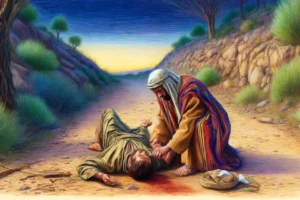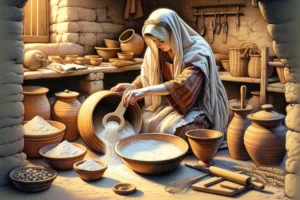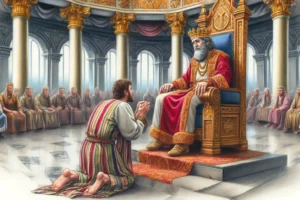
The Parable of the Lost Son
The Parable of the Lost Son, also known as the Parable of the Prodigal Son, is a famous story told by Jesus in the Gospel of Luke 15:11-32. Here are some quick facts about this parable:
- Two Sons: The story features a man who has two sons. The younger son asks for his inheritance early, which the father grants.
- Dissipation and Desperation: The younger son squanders his wealth in a distant country and faces severe poverty, eventually finding himself in a dire situation where he must feed pigs, an occupation considered unclean in Jewish culture.
- Repentance and Return: Realizing his folly, the younger son decides to return to his father, admitting his sins and willing to become like one of his father’s hired servants.
- Father’s Forgiveness: The father sees his son returning, feels compassion, and runs to embrace him. He celebrates his return with a feast, symbolizing complete forgiveness and acceptance.
- Elder Son’s Resentment: The elder son, who stayed and worked diligently for his father, resents the celebration for his wayward brother, feeling overlooked despite his loyalty.
- Themes: The parable emphasizes themes such as repentance, unconditional love, forgiveness, and the joy of redemption. It also highlights human nature in the contrasting reactions of the two brothers and the boundless grace of the father.
- Cultural Impact: This story is one of the most well-known and culturally significant parables of Jesus, influencing a wide array of literature, art, and theology, often used to discuss the nature of forgiveness and redemption.
The Parable of the Lost Son, also known as the Parable of the Prodigal Son, found in Luke 15:11-32, is one of the most profound and theologically rich stories in the New Testament. It not only encapsulates the core themes of repentance and divine grace but also delves into the complexities of human relationships and the nature of forgiveness. Here is a comprehensive analysis of this parable:
Context and Structure
The parable is part of a trio of parables about loss and recovery that Jesus tells in Luke 15—the lost sheep, the lost coin, and the lost son—which together emphasize God’s joy over the repentance of sinners. This narrative structure intensifies the message of God’s welcoming love towards those who turn back to Him.
Characters and Symbolism
- The Younger Son: Represents sinners who turn away from God, seeking autonomy and indulgence, only to find emptiness and despair. His journey reflects a deep spiritual repentance—realizing his unworthiness and deciding to return to his father, hoping for mercy.
- The Father: Symbolizes God’s boundless mercy and readiness to forgive. The father’s compassionate run to greet his son breaks all cultural expectations of a patriarch’s demeanor, emphasizing God’s unconventional grace.
- The Elder Son: Embodies the righteous who perceive themselves as faithful yet harbor resentment and self-righteousness. His struggle highlights the challenge of genuine forgiveness and the danger of moral pride.
Themes
- Repentance and Forgiveness: Central to the parable is the theme of repentance, demonstrated by the younger son’s return to his father, and forgiveness, as shown by the father’s joyful acceptance. This mirrors the Christian understanding of repentance as a turning back to God and receiving His grace without prior conditions.
- Grace and Redemption: The father’s lavish response—a robe, a ring, a feast—underscores the theme of redemption and the gratuitous nature of grace, which restores the unworthy to a place of honor.
- Jealousy and Self-Righteousness: The elder son’s reaction serves as a critique of those who believe their moral behavior obligates God to reward them. It challenges the audience to reflect on the nature of their own fidelity to God—is it driven by love or by a sense of earning divine favor?
- Reconciliation and Community: The celebration of the returned son is a festive affirmation of restored relationships, not just between father and son but within the community. It speaks to the Christian call for communal rejoicing when the lost are found.
Literary and Cultural Analysis
The parable’s setting in a first-century Jewish context amplifies its impact. The younger son’s actions—demanding his inheritance early, squandering it, and working with pigs—are profoundly disgraceful, intensifying the scandal of the father’s mercy. Meanwhile, the elder son’s behavior, while outwardly impeccable, reveals an inner spiritual bankruptcy that challenges the listener to evaluate their own spiritual state.
Conclusion
In sum, the Parable of the Lost Son is a multifaceted story that explores profound truths about God’s nature, human sin, and the possibilities for reconciliation and redemption. It encourages a deep reflection on personal attitudes towards God’s grace and challenges believers to embrace a spirit of forgiveness and celebration when others repent. This parable remains a powerful narrative that speaks across cultures and ages, calling all to recognize the depths of divine love and the joy of salvation.
Leave A Reply
You must be logged in to post a comment.




1 Comment
Sure. The Parable of the Lost Son in Luke 15:11-32 exemplifies God’s boundless mercy, showing how a repentant sinner is joyfully forgiven and welcomed back by a loving father, highlighting the joy of reconciliation with God.